Impact of Regional Pressure Dissipation on Carbon Capture and Storage Projects: A Comprehensive Review
Abstract
:1. Introduction
2. Mechanism of Regional Pressure Dissipation
3. Effect of Regional Pressure Dissipation
3.1. Storage Capacity
3.2. CO2 Plume Migration
3.3. Injectivity and Rates
3.4. Geomechanical Impacts
4. Investigation and Monitoring Strategies
5. Case Studies
6. Future Directions and Challenges
6.1. Future Directions for Regional Pressure Dissipation in CCS
6.1.1. Advanced Monitoring Technologies
6.1.2. Predictive Modelling
6.1.3. Risk Mitigation Strategies
6.1.4. International Collaboration
6.2. Challenges in Investigating Regional Pressure Dissipation in CCS
6.2.1. Lack of Long-Term Data
6.2.2. Environmental and Ecological Impacts
6.2.3. Regulatory and Policy Frameworks
6.2.4. Public Perception and Engagement
7. Conclusions
Author Contributions
Funding
Conflicts of Interest
References
- Gielen, D.; Boshell, F.; Saygin, D.; Bazilian, M.D.; Wagner, N.; Gorini, R. The role of renewable energy in the global energy transformation. Energy Strategy Rev. 2019, 24, 38–50. [Google Scholar] [CrossRef]
- Farghali, M.; Osman, A.I.; Chen, Z.; Abdelhaleem, A.; Ihara, I.; Mohamed, I.M.A.; Yap, P.-S.; Rooney, D.W. Social, environmental, and economic consequences of integrating renewable energies in the electricity sector: A review. Environ. Chem. Lett. 2023, 21, 1381–1418. [Google Scholar] [CrossRef]
- Shu, D.Y.; Deutz, S.; Winter, B.A.; Baumgärtner, N.; Leenders, L.; Bardow, A. The role of carbon capture and storage to achieve net-zero energy systems: Trade-offs between economics and the environment. Renew. Sustain. Energy Rev. 2023, 178, 113246. [Google Scholar] [CrossRef]
- Ratanpara, A.; Ricca, J.G.; Gowda, A.; Abraham, A.; Wiskoff, S.; Zauder, V.; Sharma, R.; Hafez, M.; Kim, M. Towards green carbon capture and storage using waste concrete based seawater: A microfluidic analysis. J. Environ. Manag. 2023, 345, 118760. [Google Scholar] [CrossRef] [PubMed]
- McLaughlin, H.; Littlefield, A.A.; Menefee, M.; Kinzer, A.; Hull, T.; Sovacool, B.K.; Bazilian, M.D.; Kim, J.; Griffiths, S. Carbon capture utilization and storage in review: Sociotechnical implications for a carbon reliant world. Renew. Sustain. Energy Rev. 2023, 177, 113215. [Google Scholar] [CrossRef]
- Davoodi, S.; Al-Shargabi, M.; Wood, D.A.; Rukavishnikov, V.S.; Minaev, K.M. Review of technological progress in carbon dioxide capture, storage, and utilization. Gas Sci. Eng. 2023, 117, 205070. [Google Scholar] [CrossRef]
- Eldardiry, H.; Habib, E. Carbon capture and sequestration in power generation: Review of impacts and opportunities for water sustainability. Energy Sustain. Soc. 2018, 8. [Google Scholar] [CrossRef]
- Ketzer, J.M.; Iglesias, R.S.; Einloft, S. Reducing Greenhouse Gas Emissions with CO2 Capture and Geological Storage. In Handbook of Climate Change Mitigation and Adaptation; Chen, W.-Y., Seiner, J., Suzuki, T., Lackner, M., Eds.; Springer: New York, NY, USA, 2012; Volume 3, pp. 1405–1440. [Google Scholar]
- Liu, X.; Asim, A.; Zhu, G.; Mishra, R. Theoretical and experimental investigations on the combustion characteristics of three components mixed municipal solid waste. Fuel 2020, 267, 117183. [Google Scholar] [CrossRef]
- Becattini, V.; Gabrielli, P.; Antonini, C.; Campos, J.; Acquilino, A.; Sansavini, G.; Mazzotti, M. Carbon dioxide capture, transport and storage supply chains: Optimal economic and environmental performance of infrastructure rollout. Int. J. Greenh. Gas Control 2022, 117, 103635. [Google Scholar] [CrossRef]
- Chen, X.; Zhang, Q.; Trivedi, J.; Li, Y.; Liu, J.; Liu, Z.; Liu, S. Investigation on enhanced oil recovery and CO2 storage efficiency of temperature-resistant CO2 foam flooding. Fuel 2024, 364, 130870. [Google Scholar] [CrossRef]
- Tan, Z.; Zeng, X.; Lin, B. How do multiple policy incentives influence investors’ decisions on biomass co-firing combined with carbon capture and storage retrofit projects for coal-fired power plants? Energy 2023, 278, 127822. [Google Scholar] [CrossRef]
- Zhang, L.; Wang, Y.; Miao, X.; Gan, M.; Li, X. Geochemistry in geologic CO2 utilization and storage: A brief review. Adv. Geo-Energy Res. 2019, 3, 304–313. [Google Scholar] [CrossRef]
- Ajayi, T.; Gomes, J.S.; Bera, A. A review of CO2 storage in geological formations emphasizing modeling, monitoring and capacity estimation approaches. Pet. Sci. 2019, 16, 1028–1063. [Google Scholar] [CrossRef]
- Proelss, A.; Steenkamp, R.C. Geoengineering: Methods, Associated Risks and International Liability. In Corporate Liability for Transboundary Environmental Harm: An International and Transnational Perspective; Gailhofer, P., Krebs, D., Proelss, A., Schmalenbach, K., Eds.; Springer: Cham, Switzerland, 2023. [Google Scholar]
- Qiao, X.; Li, G.; Li, M.; Wang, Z. CO2 storage capacity assessment of deep saline aquifers in the Subei Basin, East China. Int. J. Greenh. Gas Control 2012, 11, 52–63. [Google Scholar] [CrossRef]
- Yeo, I.W.; Brown, M.R.M.; Ge, S.; Lee, K.K. Causal mechanism of injection-induced earthquakes through the Mw 5.5 Pohang earthquake case study. Nat. Commun. 2020, 11, 2614. [Google Scholar] [CrossRef] [PubMed]
- Hamza, A.; Hussein, I.A.; Al-Marri, M.J.; Mahmoud, M.; Shawabkeh, R.; Aparicio, S. CO2 enhanced gas recovery and sequestration in depleted gas reservoirs: A review. J. Pet. Sci. Eng. 2021, 196, 107685. [Google Scholar] [CrossRef]
- Vafaie, A.; Cama, J.; Soler, J.M.; Kivi, I.R.; Vilarrasa, V. Chemo-hydro-mechanical effects of CO2 injection on reservoir and seal rocks: A review on laboratory experiments. Renew. Sustain. Energy Rev. 2023, 178, 113270. [Google Scholar] [CrossRef]
- Song, Y.; Jun, S.; Na, Y.; Kim, K.; Jang, Y.; Wang, J. Geomechanical challenges during geological CO2 storage: A review. Chem. Eng. J. 2023, 456, 140968. [Google Scholar] [CrossRef]
- Jacobs, H.; Gupta, A.; Möller, I. Governing-by-aspiration? Assessing the nature and implications of including negative emission technologies (NETs) in country long-term climate strategies. Glob. Environ. Chang. 2023, 81, 102691. [Google Scholar] [CrossRef]
- Almena, A.; Thornley, P.; Chong, K.; Röder, M. Carbon dioxide removal potential from decentralised bioenergy with carbon capture and storage (BECCS) and the relevance of operational choices. Biomass Bioenergy 2022, 159, 106406. [Google Scholar] [CrossRef]
- Ali, M.; Jha, N.K.; Pal, N.; Keshavarz, A.; Hoteit, H.; Sarmadivaleh, M. Recent advances in carbon dioxide geological storage, experimental procedures, influencing parameters, and future outlook. Earth-Sci. Rev. 2022, 225, 103895. [Google Scholar] [CrossRef]
- Ismail, I.; Gaganis, V. Carbon Capture, Utilization, and Storage in Saline Aquifers: Subsurface Policies, Development Plans, Well Control Strategies and Optimization Approaches—A Review. Clean Technol. 2023, 5, 609–637. [Google Scholar] [CrossRef]
- Marbun, B.T.H.; Sinaga, S.Z.; Purbantanu, B.; Santoso, D.; Kadir, W.G.A.; Sule, R.; Prasetyo, D.; Prabowo, H.; Susilo, D.; Firmansyah, F.; et al. Lesson learned from the assessment of planned converted CO2 injection well integrity in Indonesia—CCUS project. Heliyon 2023, 9, e18505. [Google Scholar] [CrossRef] [PubMed]
- Stokes, S.M.; Ge, S.; Brown, M.R.M.; Menezes, E.A.; Sheehan, A.F.; Tiampo, K.F. Pore Pressure Diffusion and Onset of Induced Seismicity. J. Geophys. Res. Solid Earth 2023, 128. [Google Scholar] [CrossRef]
- White, J.A.; Foxall, W. Assessing induced seismicity risk at CO2 storage projects: Recent progress and remaining challenges. Int. J. Greenh. Gas Control 2016, 49, 413–424. [Google Scholar] [CrossRef]
- Ge, S.; Saar, M.O. Review: Induced Seismicity During Geoenergy Development—A Hydromechanical Perspective. J. Geophys. Res. Solid Earth 2022, 127, e2021JB023141. [Google Scholar] [CrossRef]
- Rowan, L.R.; Jones, A.C. Earthquakes Induced by Underground Fluid Injection and the Federal Role in Mitigation Earth-quakes Induced by Underground Fluid Injection and the Federal Role in Mitigation. 2023. Available online: https://www.osti.gov/servlets/purl/4111086 (accessed on 1 April 2024).
- Kivi, I.R.; Boyet, A.; Wu, H.; Walter, L.; Hanson-hedgecock, S.; Parisio, F.; Vilarrasa, V. Global physics-based database of injection-induced seismicity. Earth Syst. Sci. Data 2023, 1–33. [Google Scholar] [CrossRef]
- Newell, P.; Martinez, M. Numerical assessment of fault impact on caprock seals during CO2 sequestration. Int. J. Greenh. Gas Control 2020, 94, 102890. [Google Scholar] [CrossRef]
- Tewari, R.D.; Phuat, T.C.; Sedaralit, M.F. A Toolkit Approach for Carbon Capture and Storage in Offshore Depleted Gas Field. Am. J. Environ. Sci. 2023, 19, 8–42. [Google Scholar] [CrossRef]
- Riel, B.; Simons, M.; Ponti, D.; Agram, P.; Jolivet, R. Quantifying Ground Deformation in the Los Angeles and Santa Ana Coastal Basins Due to Groundwater Withdrawal. Water Resour. Res. 2018, 54, 3557–3582. [Google Scholar] [CrossRef]
- Coda, S.; Confuorto, P.; De Vita, P.; Di Martire, D.; Allocca, V. Uplift Evidences related to the recession of groundwater abstraction in a pyroclastic-alluvial aquifer of southern Italy. Geosciences 2019, 9, 215. [Google Scholar] [CrossRef]
- Guzy, A.; Malinowska, A.A. State of the art and recent advancements in the modelling of land subsidence induced by groundwater withdrawal. Water 2020, 12, 2051. [Google Scholar] [CrossRef]
- Rasool, M.H.; Ahmad, M.; Ayoub, M. Selecting Geological Formations for CO2 Storage: A Comparative Rating System. Sustainability 2023, 15, 6599. [Google Scholar] [CrossRef]
- Liu, X.; Zhu, G.; Asim, T.; Mishra, R. Combustion characterization of hybrid methane-hydrogen gas in domestic swirl stoves. Fuel 2023, 333, 126413. [Google Scholar] [CrossRef]
- Zapata, Y.; Kristensen, M.R.; Huerta, N.; Brown, C.; Kabir, C.S.; Reza, Z. CO2 geological storage: Critical insights on plume dynamics and storage efficiency during long-term injection and post-injection periods. J. Nat. Gas Sci. Eng. 2020, 83, 103542. [Google Scholar] [CrossRef]
- Shad, S.; Razaghi, N.; Zivar, D.; Mellat, S. Mechanical behavior of salt rocks: A geomechanical model. Petroleum 2022, 9, 508–525. [Google Scholar] [CrossRef]
- Kim, K.; Vilarrasa, V.; Makhnenko, R.Y. CO2 injection effect on geomechanical and flow properties of calcite-rich reservoirs. Fluids 2018, 3, 66. [Google Scholar] [CrossRef]
- Cai, M.; Su, Y.; Li, L.; Hao, Y.; Gao, X. CO2-Fluid-Rock Interactions and the Coupled Geomechanical Response during CCUS Processes in Unconventional Reservoirs. Geofluids 2021, 2021. [Google Scholar] [CrossRef]
- Ebner, M.; Schirpke, U.; Tappeiner, U. How do anthropogenic pressures affect the provision of ecosystem services of small mountain lakes? Anthropocene 2022, 38, 100336. [Google Scholar] [CrossRef]
- Abbass, K.; Qasim, M.Z.; Song, H.; Murshed, M.; Mahmood, H.; Younis, I. A review of the global climate change impacts, adaptation, and sustainable mitigation measures. Environ. Sci. Pollut. Res. 2022, 29, 42539–42559. [Google Scholar] [CrossRef]
- Kalam, S.; Olayiwola, T.; Al-Rubaii, M.M.; Amaechi, B.I.; Jamal, M.S.; Awotunde, A.A. Carbon dioxide sequestration in underground formations: Review of experimental, modeling, and field studies. J. Pet. Explor. Prod. Technol. 2020, 11, 303–325. [Google Scholar] [CrossRef]
- Asim, T.; Mishra, R.; Ubbi, K.; Zala, K. Computational fluid dynamics based optimal design of vertical axis marine current turbines. Procedia CIRP 2013, 11, 323–327. [Google Scholar] [CrossRef]
- Hu, J.; Wang, Q.; Zhang, Y.; Meng, Z.; Zhang, J.; Fan, J. Numerical and Experimental Study on the Process of Filling Water in Pressurized Water Pipeline. Water 2023, 15, 2508. [Google Scholar] [CrossRef]
- Asim, T. Computational Fluid Dynamics Based Diagnostics and Optimal Design of Hydraulic Capsule Pipelines. Ph.D. Thesis, University of Huddersfield, Huddersfield, UK, 2013. [Google Scholar]
- Kim, M.C.; Yadav, D. Linear and Nonlinear Analyses of the Onset of Buoyancy-Induced Instability in an Unbounded Porous Medium Saturated by Miscible Fluids. Transp. Porous Media 2014, 104, 407–433. [Google Scholar] [CrossRef]
- Freegah, B.; Asim, T.; Mishra, R. Computational Fluid Dynamics based Analysis of a Closed Thermo-Siphon Hot Water Solar System. In Proceedings of the 26th International Congress on Condition Monitoring and Diagnostic Engineering Management, Helsinki, Finland, 26–28 May 2013. [Google Scholar]
- Kocharyan, G.G.; Ostapchuk, A.A.; Pavlov, D.V.; Gridin, G.A.; Morozova, K.G.; Hongwen, J.; Panteleev, I.A. Laboratory Study on Frictional Behavior of Rock Blocks of Meter Scale. Methods and Preliminary Results. Izv. Phys. Solid Earth 2022, 58, 929–940. [Google Scholar] [CrossRef]
- Singh, D.; Charlton, M.; Asim, T.; Mishra, R.; Townsend, A.; Blunt, L. Quantification of additive manufacturing induced variations in the global and local performance characteristics of a complex multi-stage control valve trim. J. Pet. Sci. Eng. 2020, 190, 107053. [Google Scholar] [CrossRef]
- Askarova, A.; Mukhametdinova, A.; Markovic, S.; Khayrullina, G.; Afanasev, P.; Popov, E.; Mukhina, E. An Overview of Geological CO2 Sequestration in Oil and Gas Reservoirs. Energies 2023, 16, 2821. [Google Scholar] [CrossRef]
- Arora, V.; Saran, R.K.; Kumar, R.; Yadav, S. Separation and sequestration of CO2 in geological formations. Mater. Sci. Energy Technol. 2019, 2, 647–656. [Google Scholar] [CrossRef]
- Zheng, H.; Shi, Z.; Kaitna, R.; Zhao, F.; de Haas, T.; Hanley, K.J. Control mechanisms of pore-pressure dissipation in debris flows. Eng. Geol. 2023, 317, 107076. [Google Scholar] [CrossRef]
- Al Hameli, F.; Belhaj, H.; Al Dhuhoori, M. CO2 Sequestration Overview in Geological Formations: Trapping Mechanisms Matrix Assessment. Energies 2022, 15, 7805. [Google Scholar] [CrossRef]
- Gheibi, S.; Holt, R.M.; Vilarrasa, V. Effect of faults on stress path evolution during reservoir pressurization. Int. J. Greenh. Gas Control 2017, 63, 412–430. [Google Scholar] [CrossRef]
- Kivi, I.R.; Pujades, E.; Rutqvist, J.; Vilarrasa, V. Cooling-induced reactivation of distant faults during long-term geothermal energy production in hot sedimentary aquifers. Sci. Rep. 2022, 12. [Google Scholar] [CrossRef] [PubMed]
- Kukha Hawez, H. Coupled Geomechanics and Transient Multiphase Flow at Fracture-Matrix Interface in Tight Reservoirs. Ph.D. Thesis, Robert Gordon University, Aberdeen, UK, 2023. [Google Scholar] [CrossRef]
- Kruszewski, M.; Montegrossi, G.; Saenger, E.H. The risk of fluid-injection-induced fault reactivation in carbonate reservoirs: An investigation of a geothermal system in the Ruhr region (Germany). Geomech. Geophys. Geo-Energy Geo-Resour. 2023, 9, 38. [Google Scholar] [CrossRef]
- Liu, Q.; Zhu, D.; Jin, Z.; Tian, H.; Zhou, B.; Jiang, P.; Meng, Q.; Wu, X.; Xu, H.; Hu, T.; et al. Carbon capture and storage for long-term and safe sealing with constrained natural CO2 analogs. Renew. Sustain. Energy Rev. 2023, 171, 113000. [Google Scholar] [CrossRef]
- Yadav, D.; Kim, M.C. The onset of transient soret-driven buoyancy convection in nanoparticle suspensions with particle-concentration-dependent viscosity in a porous medium. J. Porous Media 2015, 18, 369–378. [Google Scholar] [CrossRef]
- Wetenhall, B.; Race, J.M.; Downie, M.J. The Effect of CO2 Purity on the Development of Pipeline Networks for Carbon Capture and Storage Schemes. Int. J. Greenh. Gas Control 2014, 30, 197–211. [Google Scholar] [CrossRef]
- Szulczewski, M.L.; MacMinn, C.W.; Herzog, H.J.; Juanes, R. Lifetime of carbon capture and storage as a climate-change mitigation technology. Proc. Natl. Acad. Sci. USA 2012, 109, 5185–5189. [Google Scholar] [CrossRef]
- Zhai, X.; Atefi-Monfared, K. Production versus injection induced poroelasticity in porous media incorporating fines migration. J. Pet. Sci. Eng. 2021, 205, 108953. [Google Scholar] [CrossRef]
- Babasafari, A.A.; Ghosh, D.P.; Ratnam, T.; Rezaei, S.; Sambo, C. Geological reservoir modeling and seismic reservoir monitoring. In Seismic Imaging Methods and Applications for Oil and Gas Exploration; Elsevier: Amsterdam, The Netherlands, 2022; pp. 179–285. [Google Scholar] [CrossRef]
- Zheng, X.; Espinoza, D.N.; Vandamme, M.; Pereira, J.-M. CO2 plume and pressure monitoring through pressure sensors above the caprock. Int. J. Greenh. Gas Control 2022, 117, 103660. [Google Scholar] [CrossRef]
- Jun, S.; Song, Y.; Wang, J.; Weijermars, R. Formation uplift analysis during geological CO2-Storage using the Gaussian pressure transient method: Krechba (Algeria) validation and South Korean case studies. Geoenergy Sci. Eng. 2023, 221, 211404. [Google Scholar] [CrossRef]
- Putnis, A. Transient Porosity Resulting from Fluid—Mineral. Rev. Miner. Geochem. 2015, 80, 1–23. [Google Scholar] [CrossRef]
- Fawad, M.; Rahman, J.; Mondol, N.H. Seismic reservoir characterization of potential CO2 storage reservoir sandstones in Smeaheia area, Northern North Sea. J. Pet. Sci. Eng. 2021, 205, 108812. [Google Scholar] [CrossRef]
- Cappa, F.; Guglielmi, Y.; Nussbaum, C.; De Barros, L.; Birkholzer, J. Fluid migration in low-permeability faults driven by decoupling of fault slip and opening. Nat. Geosci. 2022, 15, 747–751. [Google Scholar] [CrossRef]
- Foulger, G.R.; Wilson, M.P.; Gluyas, J.G.; Julian, B.R.; Davies, R.J. Earth-Science Reviews Global review of human-induced earthquakes. Earth-Sci. Rev. 2018, 178, 438–514. [Google Scholar] [CrossRef]
- Vilarrasa, V.; Carrera, J.; Olivella, S. Two-phase flow effects on the CO2 injection pressure evolution and implications for the caprock geomechanical stability. E3S Web Conf. 2016, 9, 04007. [Google Scholar] [CrossRef]
- Khurshid, I.; Afgan, I. Geochemical investigation of CO2 injection in oil and gas reservoirs of middle east to estimate the formation damage and related oil recovery. Energies 2021, 14, 7676. [Google Scholar] [CrossRef]
- Mohammadian, E.; Hadavimoghaddam, F.; Kheirollahi, M.; Jafari, M.; Chenlu, X.; Liu, B. Probing Solubility and pH of CO2 in aqueous solutions: Implications for CO2 injection into oceans. J. CO2 Util. 2023, 71, 102463. [Google Scholar] [CrossRef]
- Snæbjörnsdóttir, S.; Sigfússon, B.; Marieni, C.; Goldberg, D.; Gislason, S.R.; Oelkers, E.H. Carbon dioxide storage through mineral carbonation. Nat. Rev. Earth Environ. 2020, 1, 90–102. [Google Scholar] [CrossRef]
- Yadav, D.; Nair, S.B.; Awasthi, M.K.; Ragoju, R.; Bhattacharyya, K. Linear and nonlinear investigations of the impact of chemical reaction on the thermohaline convection in a permeable layer saturated with Casson fluid. Phys. Fluids 2024, 36, 014106. [Google Scholar] [CrossRef]
- Neeraj; Yadav, S. Carbon storage by mineral carbonation and industrial applications of CO2. Mater. Sci. Energy Technol. 2020, 3, 494–500. [Google Scholar] [CrossRef]
- Bear, J.; Carrera, J. Mathematical Modeling of CO2 Storage in a Geological Formation. In Geological Storage of CO2 in Deep Saline Formations; Niemi, A., Bear, J., Bensabat, J., Eds.; Springer: Dordrecht, The Netherlands, 2017; Volume 29, p. 567. [Google Scholar]
- Yuan, T.; Ning, Y.; Qin, G. Numerical Modeling and Simulation of Coupled Processes of Mineral Dissolution and Fluid Flow in Fractured Carbonate Formations. Transp. Porous Media 2016, 114, 747–775. [Google Scholar] [CrossRef]
- Qin, F.; Beckingham, L.E. The impact of mineral reactive surface area variation on simulated mineral reactions and reaction rates. Appl. Geochem. 2021, 124, 104852. [Google Scholar] [CrossRef]
- Nguyen, T.S.; Guglielmi, Y.; Graupner, B.; Rutqvist, J. Mathematical Modelling of Fault Reactivation Induced by Water Injection. Minerals 2019, 9, 282. [Google Scholar] [CrossRef]
- Khasanov, M.K.; Rafikova, G.R.; Musakaev, N.G. Mathematical Model of Carbon Dioxide Injection into a Porous Reservoir Saturated with Methane and Its Gas Hydrate. Energies 2020, 13, 440. [Google Scholar] [CrossRef]
- Smith, J.D.; Heimisson, E.R.; Bourne, S.J.; Avouac, J.-P. Stress-based forecasting of induced seismicity with instantaneous earthquake failure functions: Applications to the Groningen gas reservoir. Earth Planet. Sci. Lett. 2022, 594, 117697. [Google Scholar] [CrossRef]
- Bin Fei, W.; Li, Q.; Wei, X.C.; Song, R.R.; Jing, M.; Li, X.C. Interaction analysis for CO2 geological storage and underground coal mining in Ordos Basin, China. Eng. Geol. 2015, 196, 194–209. [Google Scholar] [CrossRef]
- Farajzadeh, R.; Zitha, P.L.J.; Bruining, H. Enhanced mass transfer of CO2 into water: Experiment and modeling. Soc. Pet. Eng.—Eur. Conf. Exhib. 2009, 2009, 6423–6431. [Google Scholar] [CrossRef]
- Estublier, A.; Lackner, A.S. Long-term simulation of the Snøhvit CO2 storage. Energy Procedia 2009, 1, 3221–3228. [Google Scholar] [CrossRef]
- Pruess, K.; Spycher, N. ECO2N—A fluid property module for the TOUGH2 code for studies of CO2 storage in saline aquifers. Energy Convers. Manag. 2007, 48, 1761–1767. [Google Scholar] [CrossRef]
- Robinson, B.A.; Viswanathan, H.S.; Valocchi, A.J. Efficient numerical techniques for modeling multicomponent ground-water transport based upon simultaneous solution of strongly coupled subsets of chemical components. Adv. Water Resour. 2000, 23, 307–324. [Google Scholar] [CrossRef]
- Grant, N.; Gambhir, A.; Mittal, S.; Greig, C.; Köberle, A.C. Enhancing the realism of decarbonisation scenarios with practicable regional constraints on CO2 storage capacity. Int. J. Greenh. Gas Control 2022, 120, 103766. [Google Scholar] [CrossRef]
- Sohal, M.A.; Le Gallo, Y.; Audigane, P.; de Dios, J.C.; Rigby, S.P. Effect of geological heterogeneities on reservoir storage capacity and migration of CO2 plume in a deep saline fractured carbonate aquifer. Int. J. Greenh. Gas Control 2021, 108, 103306. [Google Scholar] [CrossRef]
- Asante, J.; Ampomah, W.; Rose-Coss, D.; Cather, M.; Balch, R. Probabilistic assessment and uncertainty analysis of CO2 storage capacity of the morrow b sandstone—Farnsworth field unit. Energies 2021, 14, 7765. [Google Scholar] [CrossRef]
- Rasool, M.H.; Ahmad, M. Reactivity of Basaltic Minerals for CO2 Sequestration via In Situ Mineralization: A Review. Minerals 2023, 13, 1154. [Google Scholar] [CrossRef]
- Plasynski, S.I.; Litynski, J.T.; McIlvried, H.G.; Srivastava, R.D. Progress and New Developments in Carbon Capture and Storage. Crit. Rev. Plant Sci. 2009, 28, 123–138. [Google Scholar] [CrossRef]
- Prasad, S.K.; Sangwai, J.S.; Byun, H.-S. A review of the supercritical CO2 fluid applications for improved oil and gas production and associated carbon storage. J. CO2 Util. 2023, 72, 102479. [Google Scholar] [CrossRef]
- Wetenhall, B.; Race, J.; Aghajani, H.; Barnett, J. The main factors affecting heat transfer along dense phase CO2 pipelines. Int. J. Greenh. Gas Control 2017, 63, 86–94. [Google Scholar] [CrossRef]
- Al-Mahasneh, M.; Al-Khasawneh, H.E.; Al-Zboon, K.; Al-Mahasneh, M.; Aljarrah, A. Water Influx Impact on Oil Production in Hamzeh Oil Reservoir in Northeastern Jordan: Case Study. Energies 2023, 16, 2126. [Google Scholar] [CrossRef]
- Muhammed, N.S.; Haq, B.; Al Shehri, D.A.; Al-Ahmed, A.; Rahman, M.M.; Zaman, E.; Iglauer, S. Hydrogen storage in depleted gas reservoirs: A comprehensive review. Fuel 2023, 337, 127032. [Google Scholar] [CrossRef]
- Ringrose, P.S.; Furre, A.-K.; Gilfillan, S.M.; Krevor, S.; Landrø, M.; Leslie, R.; Meckel, T.; Nazarian, B.; Zahid, A. Storage of Carbon Dioxide in Saline Aquifers: Physicochemical Processes, Key Constraints, and Scale-Up Potential. Annu. Rev. Chem. Biomol. Eng. 2021, 12, 471–494. [Google Scholar] [CrossRef]
- Verma, Y.; Vishal, V.; Ranjith, P.G. Sensitivity Analysis of Geomechanical Constraints in CO2 Storage to Screen Potential Sites in Deep Saline Aquifers. Front. Clim. 2021, 3, 720959. [Google Scholar] [CrossRef]
- Kaminskaite, I.; Piazolo, S.; Emery, A.R.; Shaw, N.; Fisher, Q.J. The Importance of Physiochemical Processes in Decarbonisation Technology Applications Utilizing the Subsurface: A Review. Earth Sci. Syst. Soc. 2022, 2, 10043. [Google Scholar] [CrossRef]
- Esposito, A.; Benson, S.M. Remediation of possible leakage from geologic CO2 storage reservoirs into groundwater aquifers. Energy Procedia 2011, 4, 3216–3223. [Google Scholar] [CrossRef]
- Krishnan, A.; Nighojkar, A.; Kandasubramanian, B. Emerging towards zero carbon footprint via carbon dioxide capturing and sequestration. Carbon Capture Sci. Technol. 2023, 9, 100137. [Google Scholar] [CrossRef]
- Bui, M.; Adjiman, C.S.; Bardow, A.; Anthony, E.J.; Boston, A.; Brown, S.; Fennell, P.S.; Fuss, S.; Galindo, A.; Hackett, L.A.; et al. Carbon capture and storage (CCS): The way forward. Energy Environ. Sci. 2018, 11, 1062–1176. [Google Scholar] [CrossRef]
- Shen, M.; Kong, F.; Tong, L.; Luo, Y.; Yin, S.; Liu, C.; Zhang, P.; Wang, L.; Chu, P.K.; Ding, Y. Carbon capture and storage (CCS): Development path based on carbon neutrality and economic policy. Carbon Neutrality 2022, 1, 37. [Google Scholar] [CrossRef]
- Wang, F.; Harindintwali, J.D.; Yuan, Z.; Wang, M.; Wang, F.; Li, S.; Yin, Z.; Huang, L.; Fu, Y.; Li, L.; et al. Technologies and perspectives for achieving carbon neutrality. Innovation 2021, 2, 100180. [Google Scholar] [CrossRef] [PubMed]
- Fominykh, S.; Stankovski, S.; Markovic, V.M.; Petrovic, D.; Osmanović, S. Analysis of CO2 Migration in Horizontal Saline Aquifers during Carbon Capture and Storage Process. Sustainability 2023, 15, 8912. [Google Scholar] [CrossRef]
- Wang, Y.; Vuik, C.; Hajibeygi, H. Analysis of hydrodynamic trapping interactions during full-cycle injection and migration of CO2 in deep saline aquifers. Adv. Water Resour. 2022, 159, 104073. [Google Scholar] [CrossRef]
- Hawez, H.; Ahmed, Z. Enhanced oil recovery by CO2 injection in carbonate reservoirs. WIT Trans. Ecol. Environ. 2014, 186, 547–558. [Google Scholar] [CrossRef]
- Wu, H.; Jayne, R.S.; Pollyea, R.M. A parametric analysis of capillary pressure effects during geologic carbon sequestration in a sandstone reservoir. Greenh. Gases Sci. Technol. 2018, 8, 1039–1052. [Google Scholar] [CrossRef]
- Kassa, A.M.; Gasda, S.E.; Landa-Marbán, D.; Sandve, T.; Kumar, K. Field-scale impacts of long-term wettability alteration in geological CO2 storage. Int. J. Greenh. Gas Control 2022, 114, 103556. [Google Scholar] [CrossRef]
- Wei, D.; Jinqiang, L.; Zhen, Y.; Zenggui, K.; Pin, Y.; Miaomiao, M.; Zijian, Z. Fluid migration patterns in shallow horizontal sand bodies pierced by vertical gas seepage in the Qiongdongnan Basin, South China Sea. J. Asian Earth Sci. 2023, 256, 105796. [Google Scholar] [CrossRef]
- Birkholzer, J.T.; Oldenburg, C.M.; Zhou, Q. CO2 migration and pressure evolution in deep saline aquifers. Int. J. Greenh. Gas Control 2015, 40, 203–220. [Google Scholar] [CrossRef]
- Celia, M.A.; Bachu, S.; Nordbotten, J.M.; Bandilla, K.W. Status of CO2 storage in deep saline aquifers with emphasis on modeling approaches and practical simulations. Water Resour. Res. 2015, 51, 6846–6892. [Google Scholar] [CrossRef]
- Jing, J.; Yang, Y.; Tang, Z. Assessing the influence of injection temperature on CO2 storage efficiency and capacity in the sloping formation with fault. Energy 2021, 215, 119097. [Google Scholar] [CrossRef]
- Zhang, K.; Lau, H.C. Sequestering CO2 as CO2 hydrate in an offshore saline aquifer by reservoir pressure management. Energy 2022, 239, 122231. [Google Scholar] [CrossRef]
- Cheng, Z.; Lu, G.; Wu, M.; Hao, Y.; Mo, C.; Li, Q.; Wu, J.; Wu, J.; Hu, B.X. The Effects of Spill Pressure on the Migration and Remediation of Dense Non-Aqueous Phase Liquids in Homogeneous and Heterogeneous Aquifers. Sustainability 2023, 15, 13072. [Google Scholar] [CrossRef]
- Shao, Q.; Boon, M.; Youssef, A.; Kurtev, K.; Benson, S.M.; Matthai, S.K. Modelling CO2 plume spreading in highly heterogeneous rocks with anisotropic, rate-dependent saturation functions: A field-data based numeric simulation study of Otway. Int. J. Greenh. Gas Control 2022, 119, 103699. [Google Scholar] [CrossRef]
- Gupta, N.; Kelley, M.; Place, M.; Cumming, L.; Mawalkar, S.; Srikanta, M.; Haagsma, A.; Mannes, R.; Pardini, R. Lessons Learned from CO2 Injection, Monitoring, and Modeling across a Diverse Portfolio of Depleted Closed Carbonate Reef Oil Fields—The Midwest Regional Carbon Sequestration Partnership Experience. Energy Procedia 2017, 114, 5540–5552. [Google Scholar] [CrossRef]
- White, J.C.; Williams, G.; Chadwick, A.; Furre, A.-K.; Kiær, A. Sleipner: The ongoing challenge to determine the thickness of a thin CO2 layer. Int. J. Greenh. Gas Control 2018, 69, 81–95. [Google Scholar] [CrossRef]
- Karvounis, P.; Blunt, M.J. Assessment of CO2 geological storage capacity of saline aquifers under the North Sea. Int. J. Greenh. Gas Control 2021, 111, 103463. [Google Scholar] [CrossRef]
- Hong, W.Y. A techno-economic review on carbon capture, utilisation and storage systems for achieving a net-zero CO2 emissions future. Carbon Capture Sci. Technol. 2022, 3, 100044. [Google Scholar] [CrossRef]
- Gupta, A.; Paul, A.R.; Saha, S.C. Decarbonizing the Atmosphere Using Carbon Capture, Utilization, and Sequestration: Challenges, Opportunities, and Policy Implications in India. Atmosphere 2023, 14, 1546. [Google Scholar] [CrossRef]
- Raza, A.; Gholami, R.; Rezaee, R.; Rasouli, V.; Rabiei, M. Significant aspects of carbon capture and storage—A review. Petroleum 2019, 5, 335–340. [Google Scholar] [CrossRef]
- Rode, D.C.; Anderson, J.J.; Zhai, H.; Fischbeck, P.S. Six principles to guide large-scale carbon capture and storage development. Energy Res. Soc. Sci. 2023, 103, 103214. [Google Scholar] [CrossRef]
- Hu, Q.; Wang, Q.; Zhang, T.; Zhao, C.; Iltaf, K.H.; Liu, S.; Fukatsu, Y. Petrophysical properties of representative geological rocks encountered in carbon storage and utilization. Energy Rep. 2023, 9, 3661–3682. [Google Scholar] [CrossRef]
- Sun, X.; Shang, A.; Wu, P.; Liu, T.; Li, Y. A Review of CO2 Marine Geological Sequestration. Processes 2023, 11, 2206. [Google Scholar] [CrossRef]
- Singh, R.P.; Shekhawat, K.S.; Das, M.K.; Muralidhar, K. Geological sequestration of CO2 in a water-bearing reservoir in hydrate-forming conditions. Oil Gas Sci. Technol.—Rev. D’ifp Energ. Nouv. 2020, 75, 51. [Google Scholar] [CrossRef]
- Luo, W.; Kottsova, A.; Vardon, P.; Dieudonné, A.; Brehme, M. Mechanisms causing injectivity decline and enhancement in geothermal projects. Renew. Sustain. Energy Rev. 2023, 185, 113623. [Google Scholar] [CrossRef]
- Budinis, S.; Krevor, S.; Mac Dowell, N.; Brandon, N.; Hawkes, A. An assessment of CCS costs, barriers and potential. Energy Strat. Rev. 2018, 22, 61–81. [Google Scholar] [CrossRef]
- Gowd, S.C.; Ganeshan, P.; Vigneswaran, V.; Hossain, S.; Kumar, D.; Rajendran, K.; Ngo, H.H.; Pugazhendhi, A. Economic perspectives and policy insights on carbon capture, storage, and utilization for sustainable development. Sci. Total. Environ. 2023, 883, 163656. [Google Scholar] [CrossRef] [PubMed]
- Vilarrasa, V.; Rinaldi, A.P.; Rutqvist, J. Long-term thermal effects on injectivity evolution during CO2 storage. Int. J. Greenh. Gas Control 2017, 64, 314–322. [Google Scholar] [CrossRef]
- Raziperchikolaee, S.; Pasumarti, A. The impact of the depth-dependence of in-situ stresses on the effectiveness of stacked caprock reservoir systems for CO2 storage. J. Nat. Gas Sci. Eng. 2020, 79, 103361. [Google Scholar] [CrossRef]
- Gauteplass, J.; Almenningen, S.; Barth, T.; Ersland, G. Hydrate plugging and flow remediation during CO2 injection in sediments. Energies 2020, 13, 4511. [Google Scholar] [CrossRef]
- Lee, H.-S.; Cho, J.; Lee, Y.-W.; Lee, K.-S. Compositional modeling of impure CO2 injection for enhanced oil recovery and CO2 storage. Appl. Sci. 2021, 11, 7907. [Google Scholar] [CrossRef]
- Allen, M.J.; Faulkner, D.R.; Worden, R.H.; Rice-Birchall, E.; Katirtsidis, N.; Utley, J.E. Geomechanical and petrographic assessment of a CO2 storage site: Application to the Acorn CO2 Storage Site, offshore United Kingdom. Int. J. Greenh. Gas Control 2020, 94, 102923. [Google Scholar] [CrossRef]
- Hawez, H.K.; Sanaee, R.; Faisal, N.H. A critical review on coupled geomechanics and fluid flow in naturally fractured reservoirs. J. Nat. Gas Sci. Eng. 2021, 95, 104150. [Google Scholar] [CrossRef]
- Tzampoglou, P.; Ilia, I.; Karalis, K.; Tsangaratos, P.; Zhao, X.; Chen, W. Selected Worldwide Cases of Land Subsidence Due to Groundwater Withdrawal. Water 2023, 15, 1094. [Google Scholar] [CrossRef]
- Luo, J.; Xie, Y.; Hou, M.Z.; Xiong, Y.; Wu, X.; Lüddeke, C.T.; Huang, L. Advances in subsea carbon dioxide utilization and storage. Energy Rev. 2023, 2, 100016. [Google Scholar] [CrossRef]
- Kumar, K.R.; Honorio, H.; Chandra, D.; Lesueur, M.; Hajibeygi, H. Comprehensive review of geomechanics of underground hydrogen storage in depleted reservoirs and salt caverns. J. Energy Storage 2023, 73, 108912. [Google Scholar] [CrossRef]
- Schäfer, F.; Walter, L.; Class, H.; Müller, C. The regional pressure impact of CO2 storage: A showcase study from the North German Basin. Environ. Earth Sci. 2012, 65, 2037–2049. [Google Scholar] [CrossRef]
- Verdon, J.P.; Kendall, J.-M.; Stork, A.L.; Chadwick, R.A.; White, D.J.; Bissell, R.C. Comparison of geomechanical deformation induced by megatonne-scale CO2 storage at Sleipner, Weyburn, and In Salah. Proc. Natl. Acad. Sci. USA 2013, 110, E2762–E2771. [Google Scholar] [CrossRef] [PubMed]
- Shi, J.-Q.; Durucan, S. A coupled reservoir-geomechanical simulation study of CO2 storage in a nearly depleted natural gas reservoir. Energy Procedia 2009, 1, 3039–3046. [Google Scholar] [CrossRef]
- Alcalde, J.; Flude, S.; Wilkinson, M.; Johnson, G.; Edlmann, K.; Bond, C.E.; Scott, V.; Gilfillan, S.M.V.; Ogaya, X.; Haszeldine, R.S. Estimating geological CO2 storage security to deliver on climate mitigation. Nat. Commun. 2018, 9, 2201. [Google Scholar] [CrossRef] [PubMed]
- Zhu, C.; Zhang, G.; Lu, P.; Meng, L.; Ji, X. Benchmark modeling of the Sleipner CO2 plume: Calibration to seismic data for the uppermost layer and model sensitivity analysis. Int. J. Greenh. Gas Control 2015, 43, 233–246. [Google Scholar] [CrossRef]
- Furre, A.-K.; Eiken, O.; Alnes, H.; Vevatne, J.N.; Kiær, A.F. 20 Years of Monitoring CO2-injection at Sleipner. Energy Procedia 2017, 114, 3916–3926. [Google Scholar] [CrossRef]
- Rahman, J.; Fawad, M.; Mondol, N.H. 3D Field-Scale Geomechanical Modeling of Potential CO2 Storage Site Smeaheia, Offshore Norway. Energies 2022, 15, 1407. [Google Scholar] [CrossRef]
- Khan, S.; Khulief, Y.; Al-Shuhail, A.; Bashmal, S.; Iqbal, N. The geomechanical and fault activation modeling during CO2 injection into deep minjur reservoir, eastern saudi arabia. Sustainability 2020, 12, 9800. [Google Scholar] [CrossRef]
- Hawez, H. Modeling of CO2 Injection in Gas Condensate Reservoirs; LAMBERT Academic Publishing: London, UK, 2015. [Google Scholar]
- Hong, J.; Jo, H.; Seo, D.; You, S. Impact of Induced Seismicity on the Housing Market: Evidence from Pohang. Buildings 2022, 12, 286. [Google Scholar] [CrossRef]
- Rutqvist, J. The geomechanics of CO2 storage in deep sedimentary formations. Geotech. Geol. Eng. 2012, 30, 525–551. [Google Scholar] [CrossRef]
- Rutqvist, J.; Rinaldi, A.P.; Cappa, F.; Jeanne, P.; Mazzoldi, A.; Urpi, L.; Guglielmi, Y.; Vilarrasa, V. Fault activation and induced seismicity in geological carbon storage—Lessons learned from recent modeling studies. J. Rock Mech. Geotech. Eng. 2016, 8, 789–804. [Google Scholar] [CrossRef]
- Rutqvist, J.; Cappa, F.; Rinaldi, A.P.; Godano, M. Modeling of induced seismicity and ground vibrations associated with geologic CO2 storage, and assessing their effects on surface structures and human perception. Int. J. Greenh. Gas Control 2014, 24, 64–77. [Google Scholar] [CrossRef]
- Pérez-López, R.; Mediato, J.F.; Rodríguez-Pascua, M.A.; Giner-Robles, J.L.; Ramos, A.; Martín-Velázquez, S.; Martínez-Orío, R.; Fernández-Canteli, P. An active tectonic field for CO2 storage management: The Hontomín onshore case study (Spain). Solid Earth 2020, 11, 719–739. [Google Scholar] [CrossRef]
- Tavani, S.; Granado, P.; Carola, E.; Rowan, M.; Muñoz, J. Comment on Ramos et al. 2022: Salt control on the kinematic evolution of the Southern Basque-Cantabrian Basin and its underground storage systems (Northern Spain). Tectonophysics 2022, 837, 229460. [Google Scholar] [CrossRef]
- Rahimi, M.; Moosavi, S.M.; Smit, B.; Hatton, T.A. Toward smart carbon capture with machine learning. Cell Rep. Phys. Sci. 2021, 2, 100396. [Google Scholar] [CrossRef]
- Ringrose, P.; Mathieson, A.; Wright, I.; Selama, F.; Hansen, O.; Bissell, R.; Saoula, N.; Midgley, J. The in salah CO2 storage project: Lessons learned and knowledge transfer. Energy Procedia 2013, 37, 6226–6236. [Google Scholar] [CrossRef]
- Rock, L.; O’brien, S.; Tessarolo, S.; Duer, J.; Bacci, V.O.; Hirst, B.; Randell, D.; Helmy, M.; Blackmore, J.; Duong, C.; et al. The Quest CCS Project: 1st Year Review Post Start of Injection. Energy Procedia 2017, 114, 5320–5328. [Google Scholar] [CrossRef]
- Duong, C.; Bower, C.; Hume, K.; Rock, L.; Tessarolo, S. Quest carbon capture and storage offset project: Findings and learnings from 1st reporting period. Int. J. Greenh. Gas Control 2019, 89, 65–75. [Google Scholar] [CrossRef]
- Gilmore, T.; Bonneville, A.; Sullivan, C.; Kelley, M.; Appriou, D.; Vermeul, V.; White, S.; Zhang, F.; Bjornstad, B.; Cornet, F.; et al. Characterization and design of the FutureGen 2.0 carbon storage site. Int. J. Greenh. Gas Control 2016, 53, 1–10. [Google Scholar] [CrossRef]
- Bonneville, A.; Gilmore, T.; Sullivan, C.; Vermeul, V.; Kelley, M.; White, S.; Appriou, D.; Bjornstad, B.; Gerst, J.; Gupta, N.; et al. Evaluating the suitability for CO2 Storage at the futuregen 2.0 Site, Morgan County, Illinois, USA. Energy Procedia 2013, 37, 6125–6132. [Google Scholar] [CrossRef]
- White, S.; Zhang, Z.; Oostrom, M. Simulation of carbon dioxide injection at the FutureGen2.0 site: Class VI permit model and local sensitivity analysis. Int. J. Greenh. Gas Control 2016, 55, 177–194. [Google Scholar] [CrossRef]
- Sharma, S.; Cook, P.; Jenkins, C.; Steeper, T.; Lees, M.; Ranasinghe, N. The CO2CRC Otway Project: Leveraging experience and exploiting new opportunities at Australia’s first CCS project site. Energy Procedia 2011, 4, 5447–5454. [Google Scholar] [CrossRef]
- Torp, T.A.; Gale, J. Demonstrating storage of CO2 in geological reservoirs: The Sleipner and SACS projects. Energy 2004, 29, 1361–1369. [Google Scholar] [CrossRef]
- Chadwick, R.; Williams, G.; Williams, J.; Noy, D. Measuring pressure performance of a large saline aquifer during industrial-scale CO2 injection: The Utsira Sand, Norwegian North Sea. Int. J. Greenh. Gas Control 2012, 10, 374–388. [Google Scholar] [CrossRef]
- Hannis, S.; Chadwick, A.; Connelly, D.; Blackford, J.; Leighton, T.; Jones, D.; White, J.; White, P.; Wright, I.; Widdicomb, S.; et al. Review of Offshore CO2 Storage Monitoring: Operational and Research Experiences of Meeting Regulatory and Technical Requirements. Energy Procedia 2017, 114, 5967–5980. [Google Scholar] [CrossRef]
- Cavanagh, A.J.; Haszeldine, R.S. The Sleipner storage site: Capillary flow modeling of a layered CO2 plume requires fractured shale barriers within the Utsira Formation. Int. J. Greenh. Gas Control 2014, 21, 101–112. [Google Scholar] [CrossRef]
- Sciandra, D.; Kivi, I.R.; Vilarrasa, V.; Makhnenko, R.Y.; Rebscher, D. Hydro-mechanical response of Opalinus Clay in the CO2 long-term periodic injection experiment (CO2LPIE) at the Mont Terri rock laboratory. Geomech. Geophys. Geo-Energy Geo-Resour. 2022, 8, 166. [Google Scholar] [CrossRef]
- Akai, T.; Kuriyama, T.; Kato, S.; Okabe, H. Numerical modelling of long-term CO2 storage mechanisms in saline aquifers using the Sleipner benchmark dataset. Int. J. Greenh. Gas Control 2021, 110, 103405. [Google Scholar] [CrossRef]
- Wright, I.; Ringrose, P.; Mathieson, A.; Eiken, O. An overview of active large-scale CO2 storage projects. In Proceedings of the SPE International Conference on CO2 Capture, Storage, and Utilization, San Diego, CA, USA, 2–4 November 2009; pp. 345–355. [Google Scholar] [CrossRef]
- Himri, Y.; Malik, A.S.; Stambouli, A.B.; Himri, S.; Draoui, B. Review and use of the Algerian renewable energy for sustainable development. Renew. Sustain. Energy Rev. 2009, 13, 1584–1591. [Google Scholar] [CrossRef]
- Davis, N.; Riddiford, F.; Bishop, C.; Taylor, B.; Froukhi, R. The in Salah Gas Project, Central Algeria: Bringing an Eight Field Gas Development to Sanction. In Proceedings of the SPE Middle East Oil Show, Manama, Bahrain, 17–20 March 2001; Volume 2, pp. 632–647. [Google Scholar] [CrossRef]
- Yadav, D.; Awasthi, M.K.; Al-Siyabi, M.; Al-Nadhairi, S.; Al-Rahbi, A.; Al-Subhi, M.; Ragoju, R.; Bhattacharyya, K. Double diffusive convective motion in a reactive porous medium layer saturated by a non-Newtonian Kuvshiniski fluid. Phys. Fluids 2022, 34, 024104. [Google Scholar] [CrossRef]
- Preisig, M.; Prévost, J.H. Coupled multi-phase thermo-poromechanical effects. Case study: CO2 injection at In Salah, Algeria. Int. J. Greenh. Gas Control 2011, 5, 1055–1064. [Google Scholar] [CrossRef]
- Jahandideh, A.; Hakim-Elahi, S.; Jafarpour, B. Inference of Rock Flow and Mechanical Properties from Injection-Induced Microseismic Events During Geologic CO2 Storage. Int. J. Greenh. Gas Control 2021, 105, 103206. [Google Scholar] [CrossRef]
- Lokey, E. Valuation of Carbon Capture and Sequestration under Greenhouse Gas Regulations: CCS as an Offsetting Activity. Electr. J. 2009, 22, 37–47. [Google Scholar] [CrossRef]
- Smith, N.; Boone, P.; Oguntimehin, A.; van Essen, G.; Guo, R.; Reynolds, M.A.; Friesen, L.; Cano, M.-C.; O’Brien, S. Quest CCS facility: Halite damage and injectivity remediation in CO2 injection wells. Int. J. Greenh. Gas Control 2022, 119, 103718. [Google Scholar] [CrossRef]
- Zhang, Z.F.; White, S.K.; White, M.D. Delineating the horizontal plume extent and CO2 distribution at geologic sequestration sites. Int. J. Greenh. Gas Control 2015, 43, 141–148. [Google Scholar] [CrossRef]
- Zhou, Q.; Birkholzer, J.T. On scale and magnitude of pressure build-up induced by large-scale geologic storage of CO2. Greenh. Gases Sci. Technol. 2011, 1, 11–20. [Google Scholar] [CrossRef]
- Person, M.; Banerjee, A.; Rupp, J.; Medina, C.; Lichtner, P.; Gable, C.; Pawar, R.; Celia, M.; McIntosh, J.; Bense, V. Assessment of basin-scale hydrologic impacts of CO2 sequestration, Illinois basin. Int. J. Greenh. Gas Control 2010, 4, 840–854. [Google Scholar] [CrossRef]
- Couëslan, M.L.; Butsch, R.; Will, R.; Locke, R.A. Integrated reservoir monitoring at the Illinois Basin—Decatur Project. Energy Procedia 2014, 63, 2836–2847. [Google Scholar] [CrossRef]
- Underschultz, J.; Boreham, C.; Dance, T.; Stalker, L.; Freifeld, B.; Kirste, D.; Ennis-King, J. CO2 storage in a depleted gas field: An overview of the CO2CRC Otway Project and initial results. Int. J. Greenh. Gas Control 2011, 5, 922–932. [Google Scholar] [CrossRef]
- Dance, T.; Spencer, L.; Xu, J.-Q. Geological characterisation of the Otway project pilot site: What a difference a well makes. Energy Procedia 2009, 1, 2871–2878. [Google Scholar] [CrossRef]
- Hortle, A.H.; Xu, J.; Dance, T. Hydrodynamic interpretation of the Waarre Fm Aquifer in the onshore Otway Basin: Implications for the CO2CRC Otway Project. Energy Procedia 2009, 1, 2895–2902. [Google Scholar] [CrossRef]
- Ma, J.; Li, L.; Wang, H.; Du, Y.; Ma, J.; Zhang, X.; Wang, Z. Carbon Capture and Storage: History and the Road Ahead. Engineering 2022, 14, 33–43. [Google Scholar] [CrossRef]
- Andersen, O.; Lie, K.-A.; Nilsen, H.M. An open-source toolchain for simulation and optimization of aquifer-wide CO2 storage. Energy Procedia 2016, 86, 324–333. [Google Scholar] [CrossRef]
- Artun, E.; Khoei, A.A.; Köse, K. Modeling, analysis, and screening of cyclic pressure pulsing with nitrogen in hydraulically fractured wells. Pet. Sci. 2016, 13, 532–549. [Google Scholar] [CrossRef]
- Cao, Z.; Wang, S.; Luo, P.; Xie, D.; Zhu, W. Watershed Ecohydrological Processes in a Changing Environment: Opportunities and Challenges. Water 2022, 14, 1502. [Google Scholar] [CrossRef]
- Romasheva, N.; Ilinova, A. CCS Projects: How regulatory framework influences their deployment. Resources 2019, 8, 181. [Google Scholar] [CrossRef]
- Mulyasari, F.; Harahap, A.; Rio, A.; Sule, R.; Kadir, W. Potentials of the public engagement strategy for public acceptance and social license to operate: Case study of Carbon Capture, Utilisation, and Storage Gundih Pilot Project in Indonesia. Int. J. Greenh. Gas Control 2021, 108, 103312. [Google Scholar] [CrossRef]
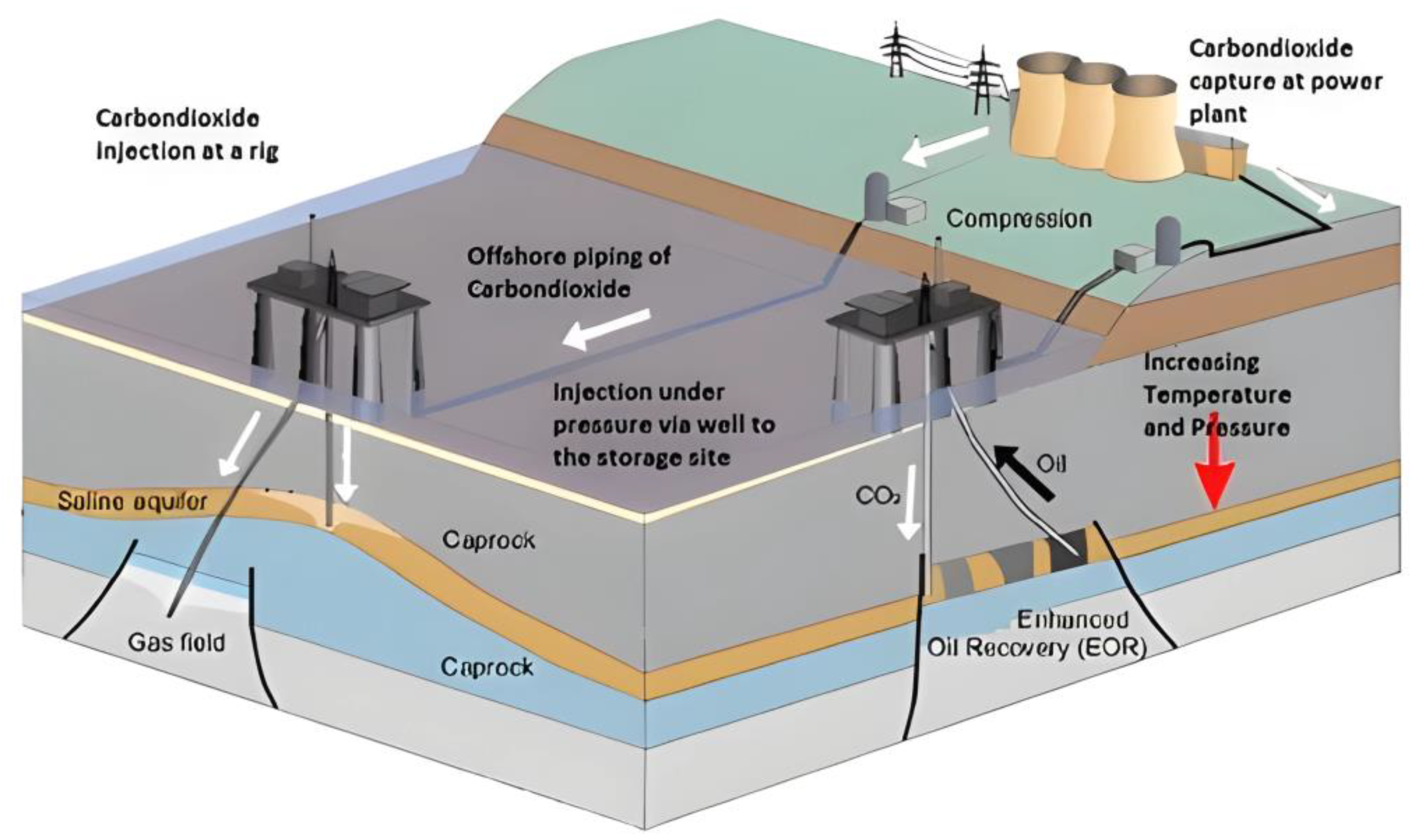
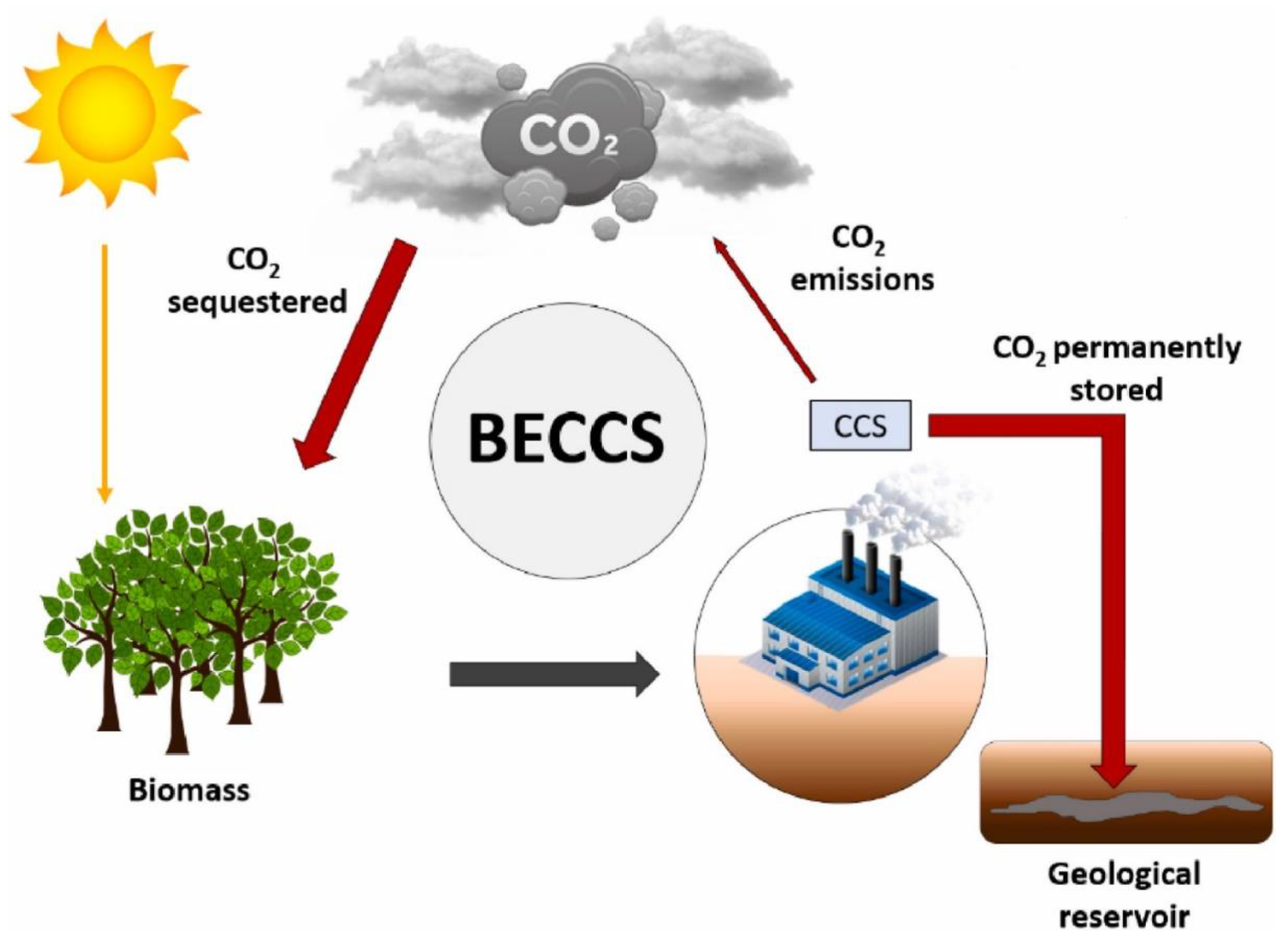
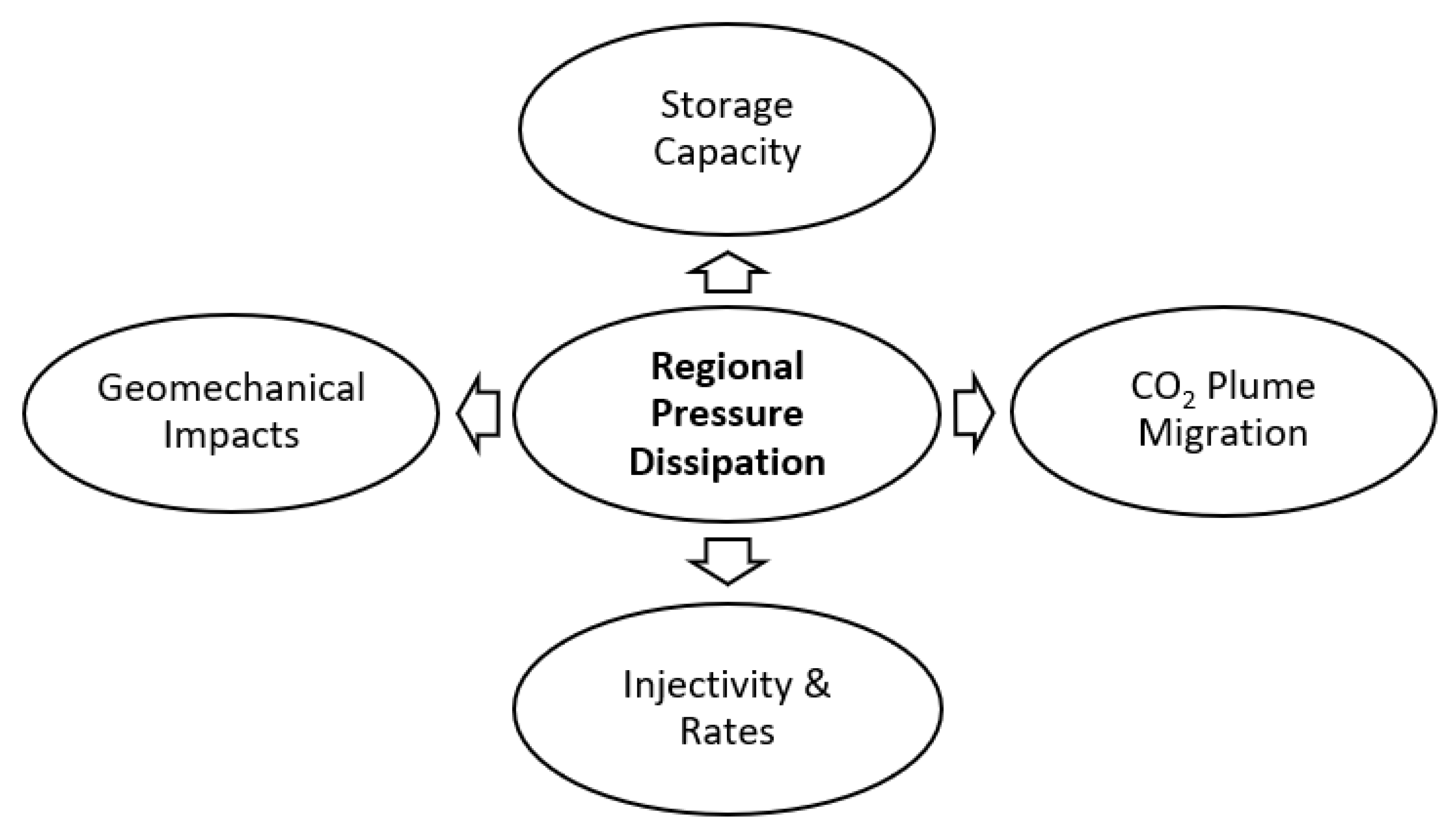
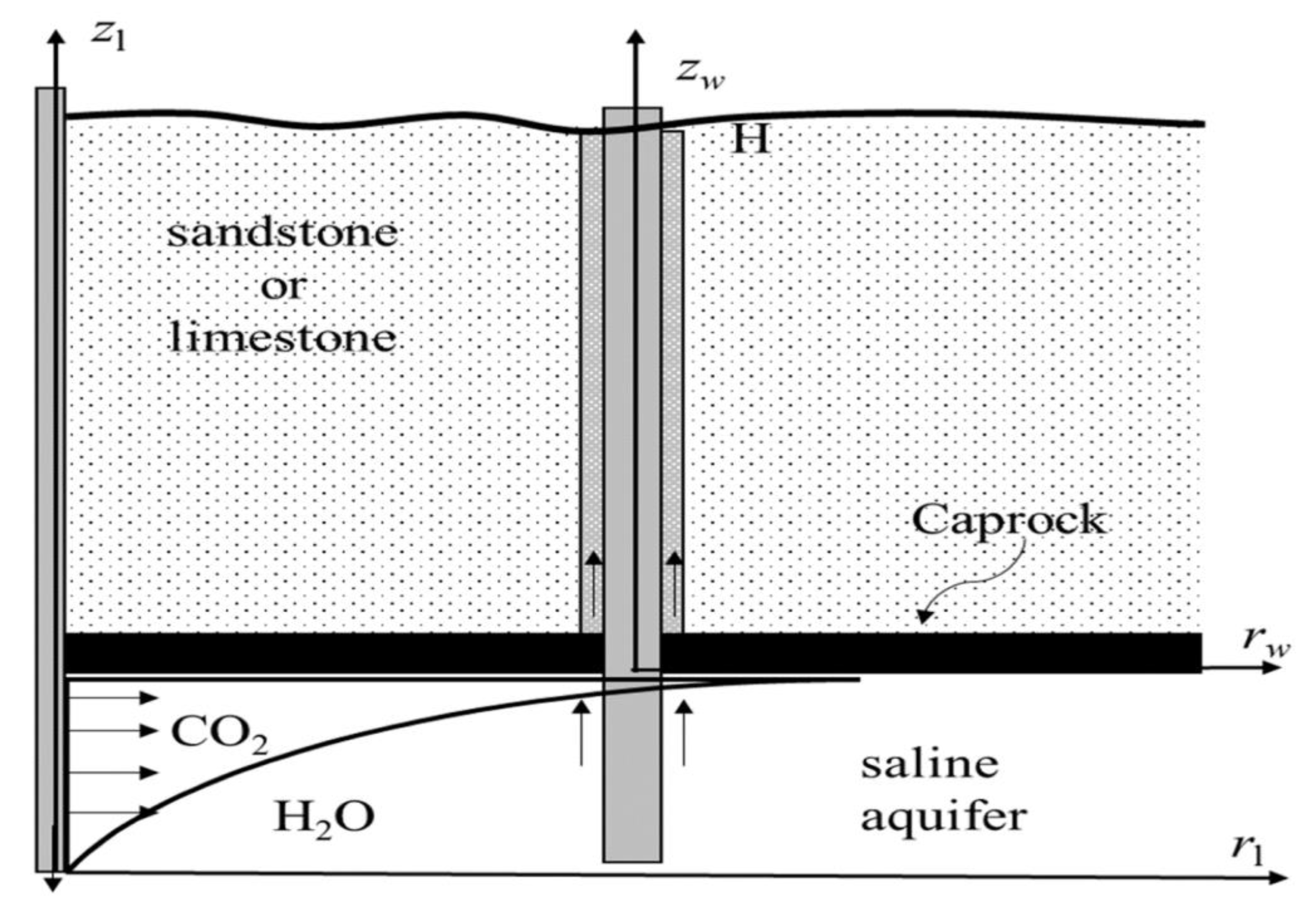
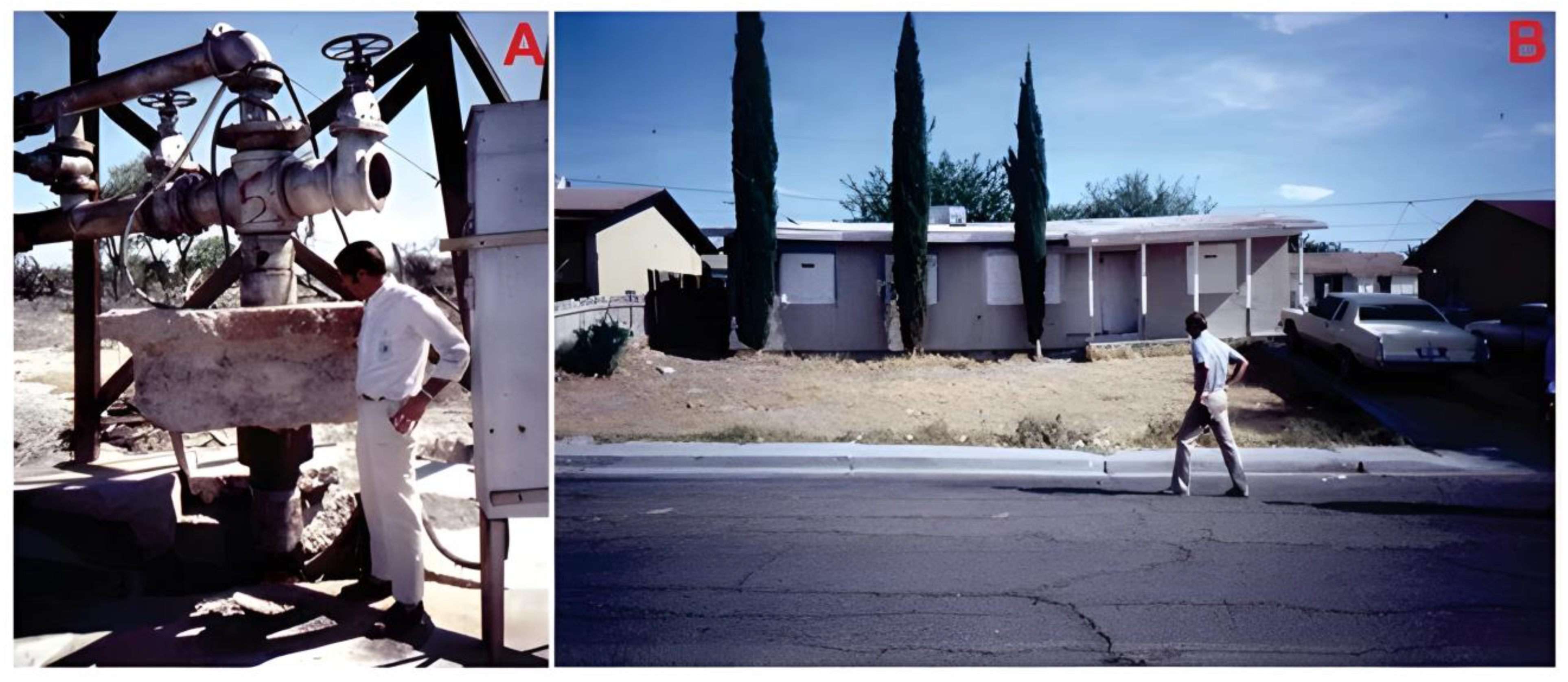
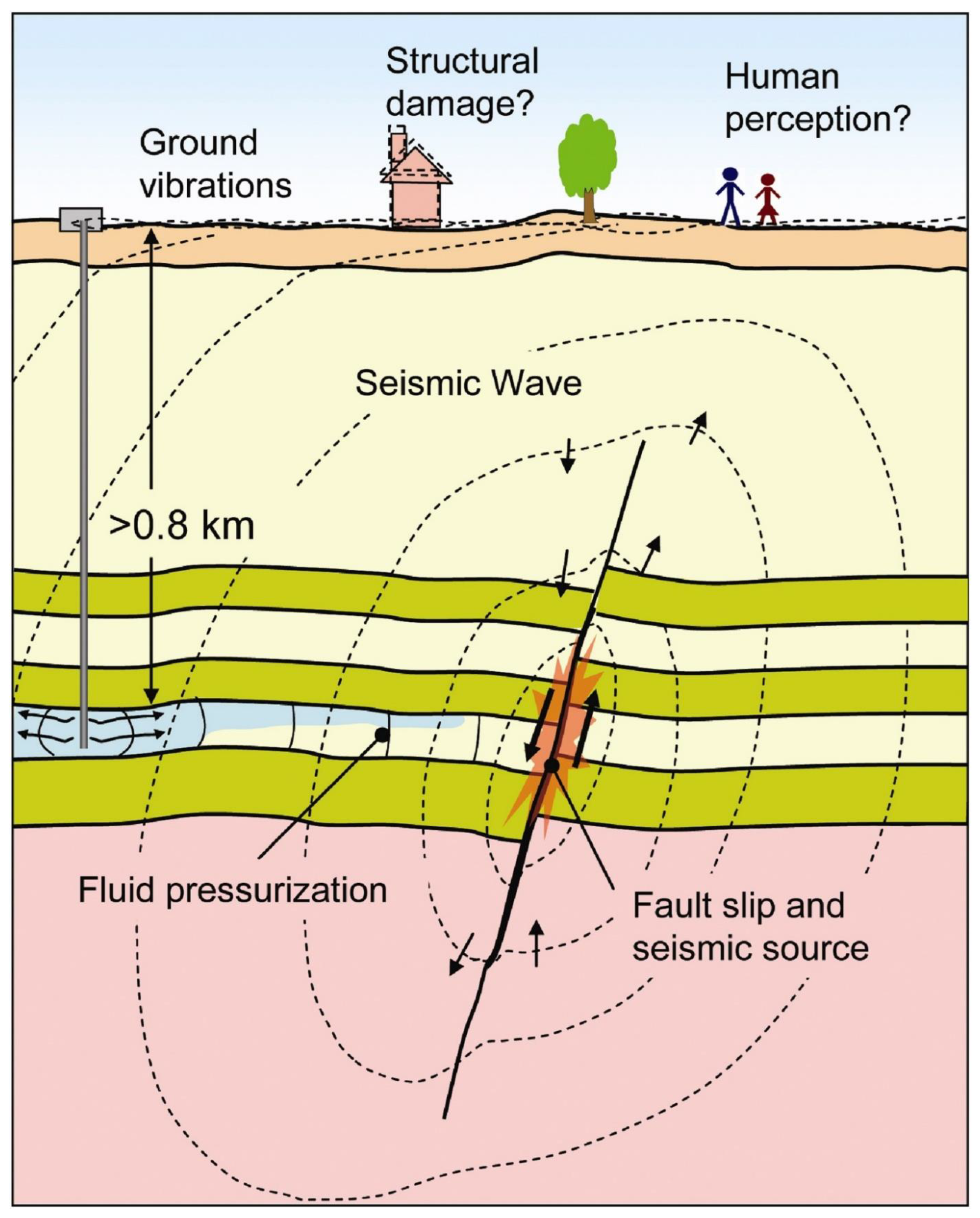
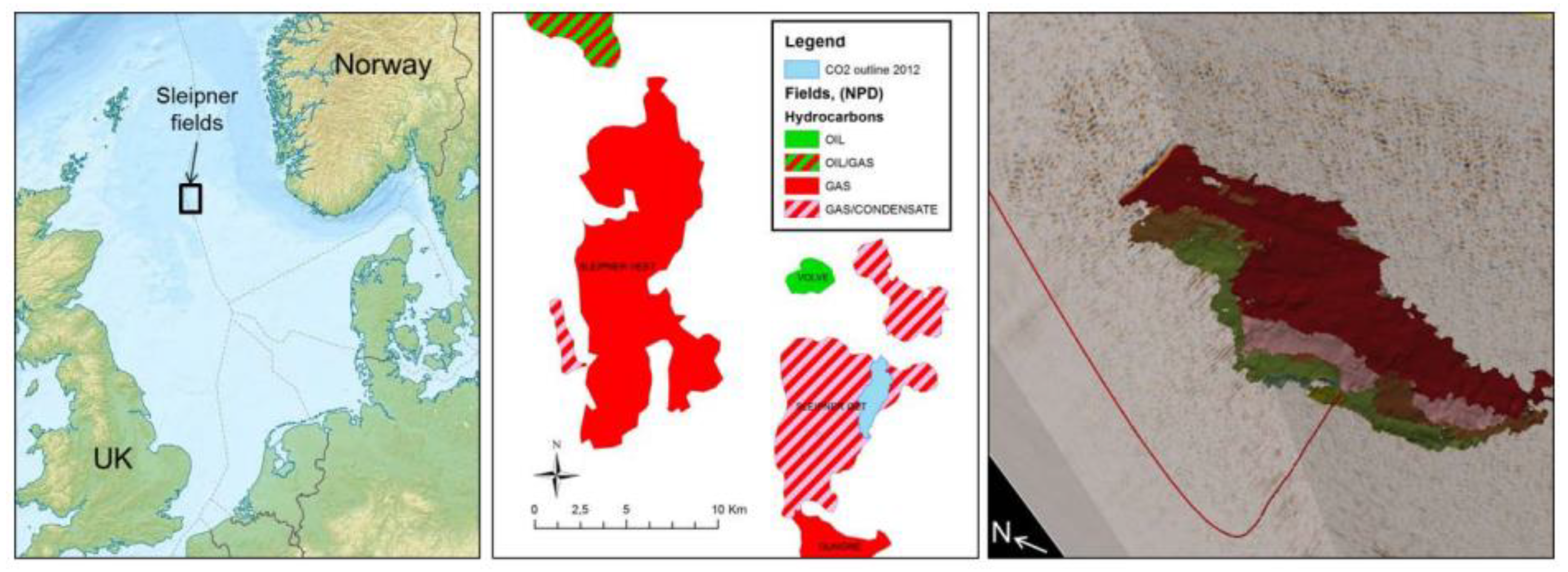

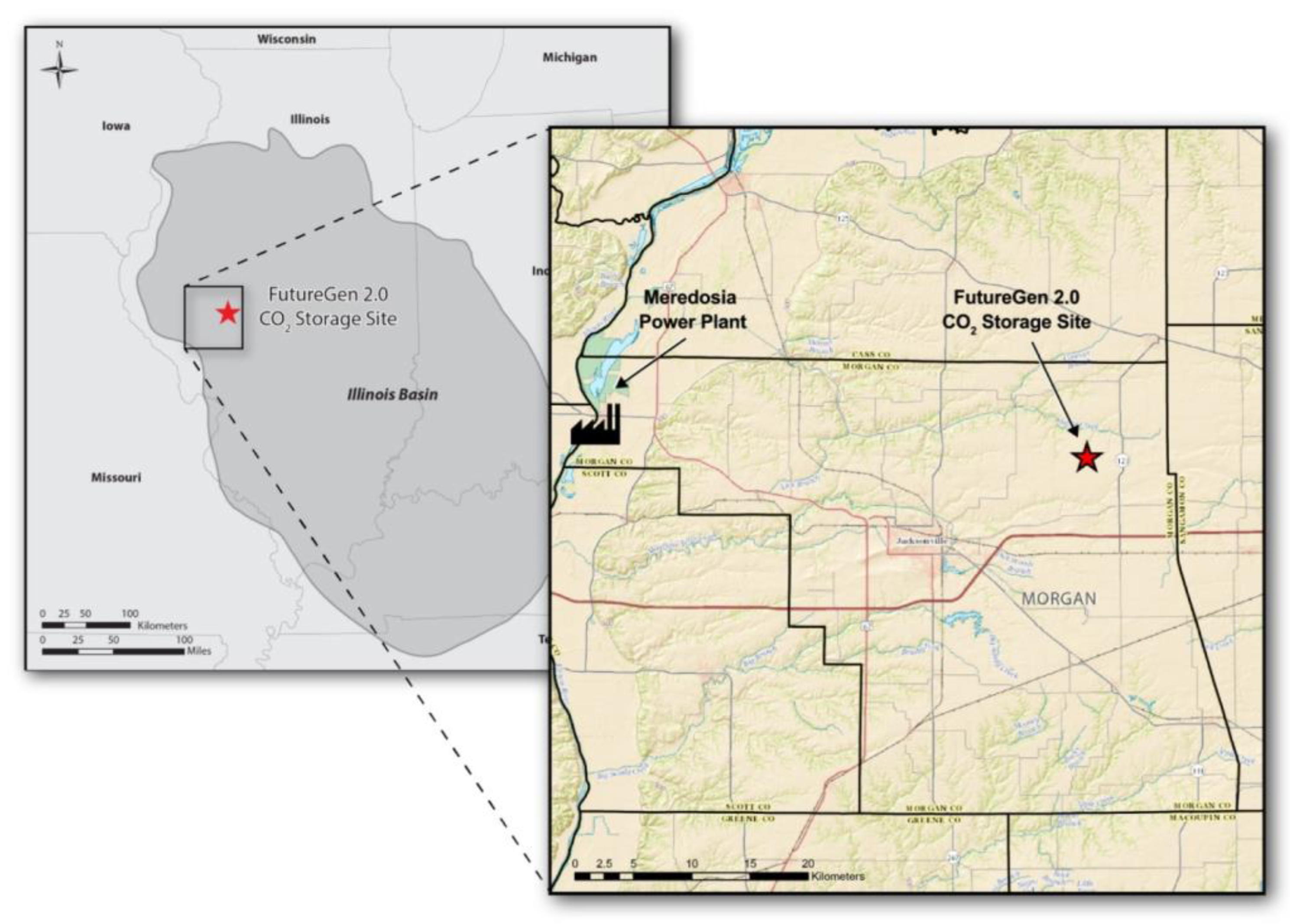
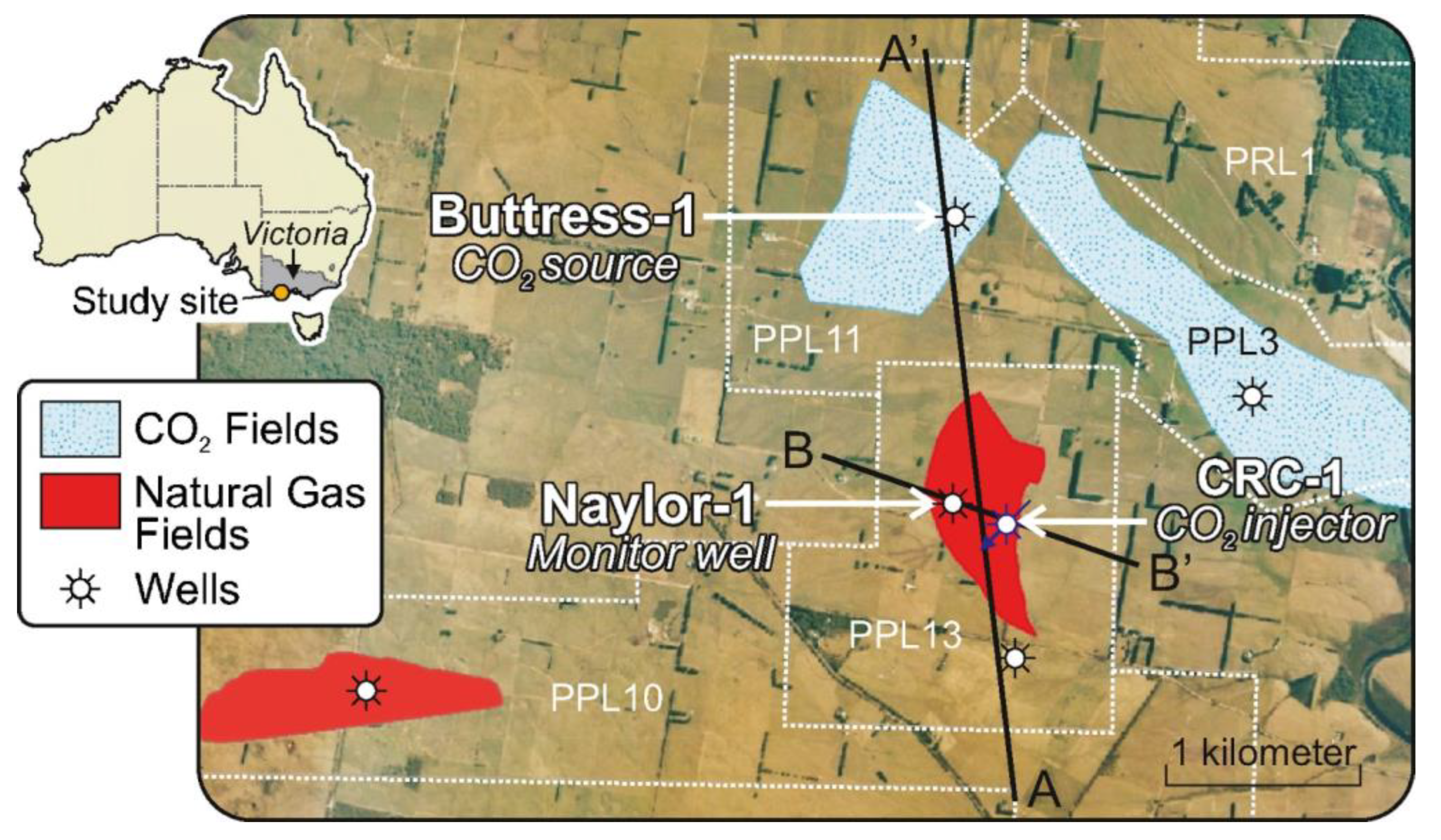
| Numerical Model | Full Name | Descriptions | Developers | Reference |
|---|---|---|---|---|
| ABAQUS-FEA | ABAQUS-Finite Element Analysis | Geomechanical, single-phase, and two-phase fluid flow. | SIMULIA | [84] |
| COMSOL | COMSOL Multiphysics | Solver for general partial differential equations using finite element methods. | COMSOL | [85] |
| COORES | CO2 Reservoir Environmental | Multi-component, three-phase, and three-dimensional fluid flow in heterogeneous porous media. | French Petroleum Institute | [86] |
| TOUGH/TOUGH2 | Transport of water and heat in unsaturated ground conditions. | Non-isothermal multiphase flow in both unfractured and fractured media. | Lawrence Berkeley National Laboratory | [87] |
| FEHM | Simulator for heat and mass transfer using finite element methods. | Non-isothermal, multiphase flow in both unfractured and fractured media, incorporating reactive geochemistry and geomechanical coupling. | Los Alamos National Laboratory | [88] |
| Study | Objective | Characteristics | Summary | Reference |
|---|---|---|---|---|
| Storage Capacity | The objective is to be provided with a realistic showcase representing many potential storage sites and their surroundings in the North German Basin. | A saline aquifer section at a sub-basin scale (approximately 50 km) from the North German Basin was utilized to simulate the injection of 25 Megatons of CO2 into an anticlinal dome structure. | The increase in regional pressure has implications for the storage capacities of adjacent sites within hydraulically interconnected units. It can be inferred that storage capacities may be significantly over- or underestimated when attention is solely on an individual storage site. | [140] |
| Storage Capacity | The objective is to offer an initial assessment of this investable potential and employ a global energy system model to investigate its implications for global and regional mitigation pathways. | The analytical framework employed in this study is the TIAM-Grantham energy system model. It encompasses a diverse array of over 30 carbon capture and storage (CCS) technologies spanning various energy system sectors, such as fuel supply. | The summary indicates that low-carbon scenarios, which presume ample CO2 storage, might significantly overstate the contribution of carbon capture and storage (CCS) to deep decarbonization, especially in critical regions like China and India. | [89] |
| CO2 Plume and Injectivity | The impact of heterogeneities on the migration of the CO2 plume and reservoir storage capacity was investigated using Eclipse (E300) software, employing the dual permeability option. | The geological model of the Hontomín site comprises a structural dome and encompasses under burden, reservoir, seal, and overburden layers. The reservoir limestone is situated at a depth of 1435 m in the injection well and spans 79 m in thickness, while the dolomite is encountered at a depth of 1514 m in HI and measures 41 m in thickness. | The influence of fault transmissibility on reservoir pressure was evident only as the CO2 plume approached the vicinity. | [90] |
| CO2 Plume | Modelling the spread of the CO2 plume in highly heterogeneous rocks involves incorporating anisotropic, rate-dependent saturation functions. | Two geostatic models and a topographic cylinder model featuring top-seal topography were constructed to examine plume migration under various conditions. These models are focused on a vertical well serving as an injector, with a radius of approximately 0.75 km, extending beyond the well’s location up to a distance of 640 m. | Noticeable distinctions in plume shape and saturation distribution emerge when utilizing the novel rate-dependent anisotropic saturation functions as opposed to conventional saturation functions. | [117] |
| Geomechanical | Three commercial sites underwent comparison under the scenario of injecting 1 megaton/year of CO2, with the geomechanical response being scrutinized through geodetic methods, seismic reflection surveys, and micro seismic monitoring. | Sleipner (Aquifer) in Norway, Weyburn (Depleted reservoir) in Central Canada, and Salah (Depleted reservoir) in Algeria | Various monitoring techniques proved effective across different sites, emphasizing the need for tailored site characterization. Salah exhibited the most significant uplift, reaching up to 2 cm, attributed to injection into the water leg of the reservoir, distinguishing it from the other sites. | [141] |
| Geomechanical | Conducting coupled hydromechanical simulations to assess CO2 injection rates entails studying the potential for shear failure and the activation of faults within the Puchkirken formation, which comprises sandstone, shale, and mudstones. | A depleted gas reservoir located in Austria has an initial pressure of 16 MPa at a depth of 1.6 km. | The Mohr–Coulomb criteria were applied, assuming the elastic response of the reservoir, to simulate the period from 1963 to 2004. Predictions indicated potential tensile deformation of up to 2.1 cm under a pressure of 20 MPa. | [142] |
| Project | Monitoring Methods | Effects | References |
|---|---|---|---|
| Sleipner Project | Downhole pressure gauges. Formation pressure testing. Geomechanical modelling | Provides real-time data on pressure changes within storage reservoirs, allowing for early detection of anomalies and ensuring reservoir integrity. Directly monitors pressure within the storage formation, verifying pressure data obtained through other monitoring techniques and assuring reservoir model accuracy. Combines pressure data into complicated models to simulate reservoir behaviour and forecast future pressure trends for more efficient injection operations and reservoir management. | [78,141,144] |
| In Salah Project | Downhole pressure gauges. Surface pressure transducers. Remote sensing and satellite monitoring. | Enables ongoing surveillance of pressure conditions deep underground, which is critical for spotting possible hazards and guaranteeing safety. Detects pressure fluctuations at the surface, identifies potential dangers or leaks, and ensures regulatory compliance. Surface deformations are tracked, which helps to detect pressure changes and associated dangers to surface infrastructure and neighbouring communities. | [67,156] |
| Quest Project | Downhole pressure gauges. Formation pressure transducers. Distributed acoustic sensing. | Allows for the modification of injection rates and operational settings to maximize storage capacity by providing insights into the behaviour and performance of reservoirs. Provides validation for reservoir models and pressure data, guaranteeing the accuracy of monitoring outcomes and assisting with efficient storage operations. Improves monitoring capabilities by identifying high-resolution spatial pressure fluctuations, which helps with risk reduction and long-term performance assessment. | [157,158] |
| FutureGen 2.0 | Downhole pressure gauges. Geomechanical Modelling. Remote sensing and satellite monitoring. | Makes it easier to monitor pressure changes in the storage reservoir in real-time, guaranteeing secure and efficient storage operations. Simulates how a reservoir will react to injection operations using geomechanical models, maximizing storage effectiveness and guaranteeing long-term integrity. Makes use of remote sensing to continuously monitor surface conditions to help identify any geohazards and guarantee operational safety. | [159,160,161] |
| Otway CCS | Downhole pressure gauges. Surface pressure transducers. Distributed acoustic sensing. | Offers constant reservoir pressure monitoring, enabling dependable and secure subterranean CO2 storage. Helps to ensure the integrity of CO2 storage operations by facilitating surface pressure monitoring for risk assessment and mitigation. Use distributed acoustic sensing technology to make sure storage operations are reliable by providing extensive reservoir pressure monitoring. | [44,117,162] |
| Project | CO2 Storage Capacity (Million Tons per Year) | Operation Duration (Years) | Achievements |
|---|---|---|---|
| Sleipner | 0.8 | Over 25 | First CCS plant on a commercial scale, a substantial decrease in CO2 emissions from natural gas production. |
| In Salah | 1.2 | Over 15 | Successful injection and storage in deep saline aquifers are the largest onshore CCS project. |
| Quest | 1.0 | Over 5 | Substantial decrease in CO2 emissions from the oil sands industry’s first CCS plant. |
| FutureGen 2.0 | 1.1 | Over 20 | Cutting-edge oxy-combustion technology strives for coal-fired power generation with almost no emissions. |
| Otway CCS | 4 | Over 15 | CCS project on a pilot scale, in-depth analysis of CO2 storage behaviour and monitoring methods |
Disclaimer/Publisher’s Note: The statements, opinions and data contained in all publications are solely those of the individual author(s) and contributor(s) and not of MDPI and/or the editor(s). MDPI and/or the editor(s) disclaim responsibility for any injury to people or property resulting from any ideas, methods, instructions or products referred to in the content. |
© 2024 by the authors. Licensee MDPI, Basel, Switzerland. This article is an open access article distributed under the terms and conditions of the Creative Commons Attribution (CC BY) license (https://creativecommons.org/licenses/by/4.0/).
Share and Cite
Hawez, H.K.; Asim, T. Impact of Regional Pressure Dissipation on Carbon Capture and Storage Projects: A Comprehensive Review. Energies 2024, 17, 1889. https://doi.org/10.3390/en17081889
Hawez HK, Asim T. Impact of Regional Pressure Dissipation on Carbon Capture and Storage Projects: A Comprehensive Review. Energies. 2024; 17(8):1889. https://doi.org/10.3390/en17081889
Chicago/Turabian StyleHawez, Haval Kukha, and Taimoor Asim. 2024. "Impact of Regional Pressure Dissipation on Carbon Capture and Storage Projects: A Comprehensive Review" Energies 17, no. 8: 1889. https://doi.org/10.3390/en17081889








